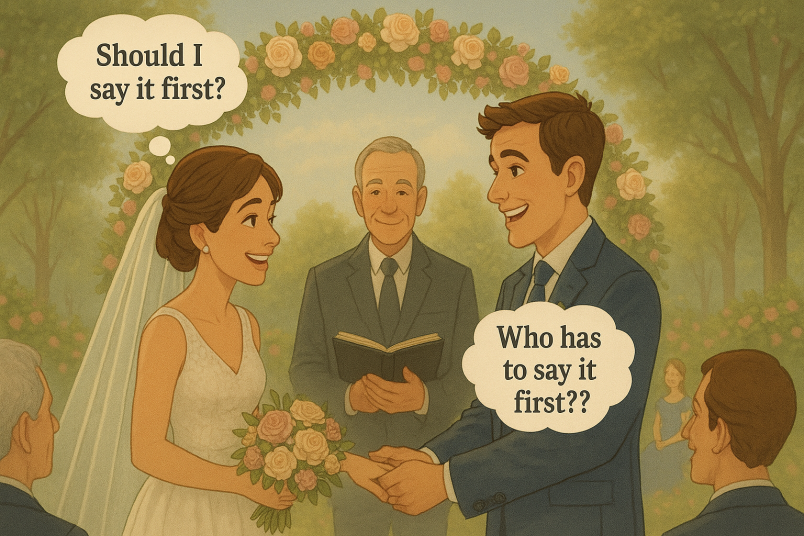Who Says I Do First: The Bride or the Groom?

Unlock Daily 30-Sec Tips for a Happier Relationship
👉 Subscribe FREEKey Takeaways
Marriage.com AI Quick Summary
Weddings are filled with tender moments, but few are as heart-stirring as that quiet pause before the words “I do.” It’s the instant where love, promises, and forever come together—sometimes with a shaky breath or a teary smile. Yet, a sweet little question often pops up amid the excitement—who says I do first?
The bride or the groom? Traditions vary, hearts race, and everyone’s watching as two souls make it official. Whether whispered softly or spoken with joy, that simple phrase carries the weight of a lifetime; a moment that lingers long after the music fades.
What is the significance of “I do” in marriage
“I do” is more than just a formality—it’s a heartfelt promise that marks the moment two people choose each other completely. In marriage, those two simple words symbolize consent, love, and commitment; they seal the bond between two hearts ready to build a life together.
A research paper published in 1980 states that using a symbolic-ritual framework helps couples create wedding ceremonies with deeper personal meaning, reflecting their values, emotions, and shared life story.
Who says I do first in a wedding ceremony
The order of wedding vows usually follows a beautiful rhythm—exchange of promises, the “I do,” and finally, the rings.While traditions vary, many wonder who says I do first or who says I do first in a wedding—a tiny detail carrying timeless meaning and love.
1. Traditional order: Groom first
Historically, the groom often recites his vows first, a practice rooted in many cultural and religious ceremonies.
A research paper published in Weddings states that weddings are patterned, symbolic rituals shaped by cultural norms, reinforcing identity, relationships, and social structure through shared symbols and communal participation.
This order upholds the classical matrimonial customs, symbolizing traditional roles and expectations prevalent in many societies.
Benefits of following the traditional order:
- Honors long-standing cultural and religious customs.
- Adds a sense of structure and symbolism to the ceremony.
- Creates a familiar flow appreciated by families and guests.
- Reflects respect for heritage and classic wedding etiquette.
- Sets a calm, confident tone for the exchange of vows.
Considerations for traditional order:
- It may feel less personalized for couples seeking a modern approach.
- It can reinforce traditional gender roles that are not aligned with every couple’s values.
- Some officiants or families may expect this format, limiting flexibility.
- The emphasis on convention might overshadow personal expression.
- Couples should discuss comfort levels and preferences with the officiant beforehand.
2. Modern trends: Flexibility and personalization
Today, many couples are choosing to personalize the order of their vows. This flexibility reflects the modern views of equality and partnership within the relationship. It’s particularly prominent in non-traditional or contemporary ceremonies, allowing couples to express their unique relationship and journey in a more meaningful way.
Benefits of choosing a non-traditional order
- Opting for a non-traditional order in wedding vows allows for a more personal and memorable ceremony.
- It promotes equality between partners and can be inclusive of diverse cultural practices.
- This approach reflects the unique personality, values, and story of the couple.
- Resonates strongly with guests who appreciate individuality.
- Allows both partners to express love authentically and comfortably.
Considerations for non-traditional orders
- It’s important to be mindful of guest expectations and cultural norms. Couples should balance their personal preferences with traditional family values to maintain harmony.
- Ensuring the ceremony flows cohesively is crucial, which requires clear communication with the officiant or wedding planner about the preferred sequence.
- The overall tone and theme of the wedding should also be considered to ensure the vow order complements the ceremony.
Watch this TED Talk by Jen Siomacco, co-owner & creative director, who shares how weddings shape identity, representation, and why we should care about how we ritualize love.
How to decide who says “I do” first during the ceremony
Deciding the order of vows can feel like a small detail, but it holds sentimental meaning for many couples. Wondering who says I do first or in a wedding ceremony who says I do first often comes down to personal values, comfort, and symbolism.
- Follow tradition: Let the groom go first to honor classic wedding customs and maintain a sense of timeless formality.
- Embrace equality: Say “I do” together—it’s a beautiful symbol of partnership and shared commitment.
- Flip the order: Have the bride go first to represent confidence, modernity, or simply her preference.
- Match personality: Choose based on who’s more comfortable speaking first or enjoys leading emotional moments.
- Make it meaningful: Decide together based on what feels true to your relationship’s story and emotional rhythm.
Please note:
This is one of the most important moments of your life—make it yours, make it heartfelt, and make it worth it.
FAQs
Choosing who says “I do” first in a wedding is a decision steeped in tradition and personal preference. Here are some common questions answered:
-
When did the tradition of the groom saying “I do” first begin?
The tradition dates back to historical Christian ceremonies where the groom would vow first, symbolizing his commitment and leadership in the marital relationship. It’s a custom that has evolved over time, with its origins in religious practices.
-
Are there any religious restrictions on the order of vows?
Certain religions may have specific guidelines about the order of vows. For instance, in traditional Christian ceremonies, the groom often vows first, whereas in Jewish ceremonies, the bride may go first. It’s important to consult with religious leaders or ceremony officiants for guidance.
-
What are some creative ways to personalize the order of vows?
Couples can alternate phrases, integrate a poem or song, or even have a third party, like a close friend or family member, lead parts of their vows. Personalizing vows can also involve writing individual statements that reflect their unique journey and promises to each other.
Vows of the future
In the end, who says I do first is less about order and more about meaning. Whether you follow tradition or craft your own version, what truly matters is the love and intention behind those two powerful words.
Every couple’s “I do” moment is unique—an expression of their promises, personalities, and shared journey. So, whether it’s the bride, the groom, or both together, let your vows reflect your story. After all, it’s not just about who speaks first, but how deeply you mean it.
 Tips
Tips
Write your tip or submit a video tip
All tips are reviewed before the publishing.
Share this article on
Want to have a happier, healthier marriage?
If you feel disconnected or frustrated about the state of your marriage but want to avoid separation and/or divorce, the marriage.com course meant for married couples is an excellent resource to help you overcome the most challenging aspects of being married.
Recent Articles
Related Quizzes
Unlock Daily 30-Sec Tips for a Happier, Healthier Relationship
👉 Subscribe FREE on YouTube We'd love your feedback!
We'd love your feedback!
 Expert Q&A
Expert Q&A
Ask your question related to this topic & get the support you deserve from experts.



















 Thanks for your feedback!
Thanks for your feedback!